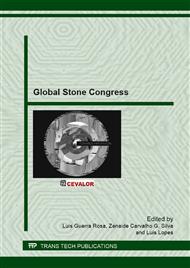p.98
p.106
p.115
p.124
p.135
p.141
p.147
p.157
p.173
Use of Quartzite Quarries Wastes in Civil Construction
Abstract:
The extraction of the dimension stone quartzite in the state of Minas Gerais, Brazil, has been done mostly in small quarries, at very low recovery levels, generating approximately six million tons of waste by year. The aim of this investigation is to study the application of the quartzite waste as aggregate in the civil construction. Laboratory tests of crushing and grinding were done to assess the technical and economic viability of reducing the size of coarse material rendering it adequate to be used as raw material in industrialized mortars and concrete pre-molded components. Samples of concrete using quartzite waste as aggregate were molded in proportions and water content used in the production of pre-molded components and the final compressive strength was assessed. Then, samples of mortars with quartzite waste as aggregate were molded with variations in proportion, water content and top size of aggregates, to assess the workability and final compressive strength. It was concluded that with a single stage of crushing, the waste generated could be used in the production of pre-molded components. An additional stage of grinding would be required for use of a larger amount of quartzite waste in the production of mortars. The alkali-aggregate reaction was not considered in this study.
Info:
Periodical:
Pages:
135-140
Citation:
Online since:
April 2013
Keywords:
Price:
Сopyright:
© 2013 Trans Tech Publications Ltd. All Rights Reserved
Share:
Citation:


